Medina (/məˈdiːnə/; Arabic: المدينة المنورة, al-Madīnah al-Munawwarah, "the radiant city"; or المدينة, al-Madīnah, "the city"), also transliterated as Madīnah, is a city in the Hejaz, and the capital of the Al Madinah Region of Saudi Arabia. The city contains al-Masjid an-Nabawi ("the Prophet's Mosque"), which is the burial place of the Islamic prophet Muhammad, and is the second-holiest city in Islam after Mecca.
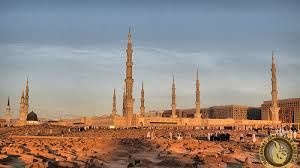
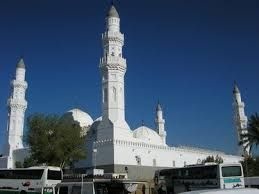
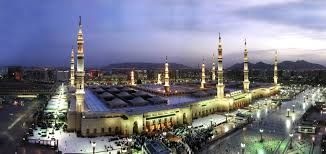
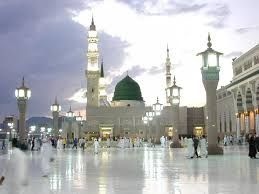
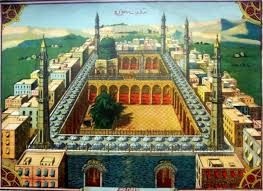
Medina was Muhammad's destination after his Hijrah from Mecca, and became the capital of a rapidly increasing Muslim Empire, first under Muhammad's leadership, and then under the first four Rashidun caliphs, Abu Bakr, Umar,Uthman, and Ali. It served as the power base of Islam in its first century where the early Muslim community developed. Medina is home to the three oldest mosques, namely the Quba Mosque, al-Masjid an-Nabawi,[2] andMasjid al-Qiblatayn ("the mosque of the two qiblas"). Muslims believe that the chronologically final surahs of theQuran were revealed to Muhammad in Medina, and are called Medinan surahs in contrast to the earlier Meccan surahs.[3][4]
Similar to Mecca, non-Muslims are forbidden from entering the sacred core of Medina (but not the entire city) or the city center by the national government.[5][6][7]
Etymology[edit]
The Arabic word al-Madīnah (المدينة) simply means "the city". Before the advent of Islam, the city was known asYathrib (pronounced [ˈjaθrib]; يثرب). The word Yathrib has been recorded in Surat al-Ahzab of the Quran.[Quran 33:13]
Also called Taiba ([ˈtˤajba]; طيبة). An alternative name is al-Madīnah an-Nabawīyah (المدينة النبوية) or Madīna-tu an-Nabī"the city of the Prophet".
Overview[edit]
As of 2006, the city of Medina has a population of about 1.3 million. In addition to its Arab inhabitants, during the pre-Islamic era Yathrib was inhabited by Jewish refugees. Later the city's name was changed to al-Madīnatu n-Nabī(المدينة النبي "city of the prophet") or al-Madīnatu 'l-Munawwarah (المدينة المنورة "the enlightened city" or "the radiant city"). Medina is celebrated for containing al-Masjid an-Nabawi and also as the city which gave refuge to him and his followers, and so ranks as the second holiest city of Islam, after Mecca. Muhammad was buried in Medina, under the Green Dome, as were the first two Rashidun caliphs, Abu Bakr and Umar, who were buried next to him in what used to be Muhammad's house.[8]
Medina is 210 miles (340 km) north of Mecca and about 120 miles (190 km) from the Red Sea coast. It is situated in the most fertile part of all the Hejaz territory, the streams of the vicinity tending to converge in this locality. An immense plain extends to the south; in every direction the view is bounded by hills and mountains.
The historic city formed an oval, surrounded by a strong wall, 30 to 40 feet (9.1 to 12.2 m) high, dating from the 12th century CE, and was flanked with towers, while on a rock, stood a castle. Of its four gates, the Bab-al-Salam, or Egyptian gate, was remarkable for its beauty. Beyond the walls of the city, west and south were suburbs consisting of low houses, yards, gardens and plantations. These suburbs also had walls and gates. Almost all of the historic city has been demolished in the Saudi era. The rebuilt city is centred on the vastly expanded al-Masjid an-Nabawi.
The graves of Fatimah (Muhammad's daughter) and Hasan (Muhammad's grandson), across from the mosque at Jannat al-Baqi, and Abu Bakr (first caliph and the father of Muhammad's wife, Aisha), and of Umar (Umar ibn Al-Khattab), the second caliph, are also here. The mosque dates back to the time of Muhammad, but has been twice reconstructed.[9]
Because of the Saudi government's religious policy and concern that historic sites could become the focus for idolatry, much of Medina's Islamic physical heritage has been altered.
Religious significance in Islam
Medina's importance as a religious site derives from the presence of al-Masjid an-Nabawi. The mosque was expanded by the Umayyad Caliph Al-Walid I. Mount Uhud is a mountain north of Medina which was the site of the second battle betweenMuslim and Meccan forces.
The first mosque built during Muhammad's time is also located in Medina and is known as the Quba Mosque. It was destroyed by lightning, probably about 850 CE, and the graves were almost forgotten. In 892, the place was cleared up, the graves located and a fine mosque built, which was destroyed by fire in 1257 CE and almost immediately rebuilt. It was restored by Qaitbay, the Egyptian ruler, in 1487.[9]
Masjid al-Qiblatain is another mosque also historically important to Muslims. It is where the command was sent to Muhammad to change the direction of prayer (qibla) from Jerusalem to Mecca according to authentic Hadith.[10]
Like Mecca, the city of Medina only permits Muslims to enter, although the haram (area closed to non-Muslims) of Medina is much smaller than that of Mecca, with the result that many facilities on the outskirts of Medina are open to non-Muslims, whereas in Mecca the area closed to non-Muslims extends well beyond the limits of the built-up area. Both cities' numerous mosques are the destination for large numbers of Muslims on their Umrah(second pilgrimage after Hajj). Hundreds of thousands of Muslims come to Medina annually while performing pilgrimage Hajj. Al-Baqi' is a significant cemetery in Medina where several family members of Muhammad, caliphs and scholars are buried.
Islamic scriptures emphasize the sacredness of Medina. Medina is mentioned several times as being sacred in the Quran, for example ayah; 9:101, 9:129, 59:9, and ayah 63:7. Medinan suras are typically longer than their Mecca counterparts. There is also a book within the hadith of Bukhari titled 'virtues of Medina'.[11]
Sahih Bukhari says:
Narrated Anas: The Prophet said, "Medina is a sanctuary from that place to that. Its trees should not be cut and no heresy should be innovated nor any sin should be committed in it, and whoever innovates in it an heresy or commits sins (bad deeds), then he will incur the curse of Allah, the angels, and all the people."
History
Jewish influence[edit]
By the fourth century, Arab tribes began to encroach from Yemen, and there were three prominent Jewish tribes that inhabited the city into the 7th century AD: theBanu Qaynuqa, the Banu Qurayza, and Banu Nadir.[12] Ibn Khordadbeh later reported that during the Persian Empire's domination in Hejaz, the Banu Qurayza served as tax collectors for the shah.[13]
Historic Medina
The situation changed after the arrival from Yemen of two new Arab tribes named Banu Aus (or Banu 'Aws) and Banu Khazraj. At first, these tribes were allied with Jewish rulers, but later they revolted and became independent.[14] Toward the end of the 5th century,[15] the Jewish rulers lost control of the city to Banu Aus and Banu Khazraj. The Jewish Encyclopediastates that "by calling in outside assistance and treacherously massacring at a banquet the principal Jews", Banu Aus and Banu Khazraj finally gained the upper hand at Medina.[12]
Most modern historians accept the claim of the Muslim sources that after the revolt, the Jewish tribes became clients of the Aus and the Khazraj.[16] However, according to scholar of Islam William Montgomery Watt, the clientship of the Jewish tribes is not borne out by the historical accounts of the period prior to 627, and he maintained that the Jewish populace retained a measure of political independence.[14]
Early Muslim chronicler Ibn Ishaq tells of a pre-Islamic conflict between the last Yemenite king of the Himyarite Kingdom[17] and the residents of Yathrib. When the king was passing by the oasis, the residents killed his son, and the Yemenite ruler threatened to exterminate the people and cut down the palms. According to Ibn Ishaq, he was stopped from doing so by two rabbis from the Banu Qurayza tribe, who implored the king to spare the oasis because it was the place "to which a prophet of the Quraysh would migrate in time to come, and it would be his home and resting-place." The Yemenite king thus did not destroy the town and converted to Judaism. He took the rabbis with him, and in Mecca, they reportedly recognized the Ka'ba as a temple built by Abraham and advised the king "to do what the people of Mecca did: to circumambulate the temple, to venerate and honour it, to shave his head and to behave with all humility until he had left its precincts." On approaching Yemen, tells ibn Ishaq, the rabbis demonstrated to the local people a miracle by coming out of a fire unscathed and the Yemenites accepted Judaism.[18]
Eventually the Banu Aus and the Banu Khazraj became hostile to each other and by the time of Muhammad's Hijra (emigration) to Medina in 622 AD/1 AH, they had been fighting for 120 years and were the sworn enemies of each other.[19] The Banu Nadir and the Banu Qurayza were allied with the Aus, while the Banu Qaynuqa sided with the Khazraj.[20] They fought a total of four wars.[14]
Their last and bloodiest battle was the Battle of Bu'ath[14] that was fought a few years before the arrival of Muhammad.[12] The outcome of the battle was inconclusive, and the feud continued. Abd-Allah ibn Ubayy, one Khazraj chief, had refused to take part in the battle, which earned him a reputation for equity and peacefulness. Until the arrival of Muhammad, he was the most respected inhabitant of Yathrib. To solve the ongoing feud, concerned residents of the city met secretly with Muhammad in Al-Aqaba, a place betweeh Makkah and Mina, inviting him and his small band of believers to come to Yathrib, where Muhammad could serve as disinterested mediator between the factions and his community could practice its faith freely.
Muhammad's arrival[edit]
The Quba Mosque is the first mosque in history built by Muhammad upon arrival in Medina
Main article: Hijra (Islam)
Main article: Constitution of Medina
In 622 AD/1 AH, Muhammad and around 70 Meccan Muhajirun believers left Mecca for sanctuary in Yathrib, an event that transformed the religious and political landscape of the city completely; the longstanding enmity between the Aus and Khazraj tribes was dampened as many of the two Arab tribes and some local Jews embraced Islam. Muhammad, linked to the Khazraj through his great-grandmother, was agreed on as civic leader. The Muslim converts native to Yathrib of whatever background—pagan Arab or Jewish—were called Ansar ("the Patrons" or "the Helpers").
According to Ibn Ishaq, the local pagan Arab tribes, the Muslim Muhajirun from Mecca, the local Muslims (Ansar), and the Jewish population of the area signed an agreement, the Constitution of Medina, which committed all parties to mutual cooperation under the leadership of Muhammad. The nature of this document as recorded by Ibn Ishaq and transmitted byIbn Hisham is the subject of dispute among modern Western historians, many of whom maintain that this "treaty" is possibly a collage of different agreements, oral rather than written, of different dates, and that it is not clear exactly when they were made. Other scholars, however, both Western and Muslim, argue that the text of the agreement—whether a single document originally or several—is possibly one of the oldest Islamic texts we possess.[21]
Battle of Badr[edit]
[show]v
t
e
List of expeditions of Muhammad
Main article: Battle of Badr
Battle positions at Badr
The Battle of Badr was a key battle in the early days of Islam and a turning point in Muhammad's struggle with his opponents among the Quraysh in Mecca.
In the spring of 624, Muhammad received word from his intelligence sources that a trade caravan, commanded by Abu Sufyan ibn Harb and guarded by thirty to forty men, was traveling from Syria back to Mecca. Muhammad gathered an army of 313 men, the largest army the Muslims had put in the field yet. However, many early Muslim sources, including the Quran, indicate that no serious fighting was expected,[22] and the future Caliph Uthman ibn Affan stayed behind to care for his sick wife.
As the caravan approached Medina, Abu Sufyan began hearing from travelers and riders about Muhammad's planned ambush. He sent a messenger named Damdam to Mecca to warn the Quraysh and get reinforcements. Alarmed, the Quraysh assembled an army of 900–1,000 men to rescue the caravan. Many of the Qurayshi nobles, including Amr ibn Hishām, Walid ibn Utba, Shaiba, and Umayyah ibn Khalaf, joined the army. However, some of the army was to later return to Mecca before the battle.
The battle started with champions from both armies emerging to engage in combat. The Muslims sent out Ali, Ubaydah ibn al-Harith (Obeida), and Hamza ibn ‘Abd al-Muttalib. The Muslims dispatched the Meccan champions in a three-on-three mêlée, Hamzah killed his victim with the very first strike, although Ubaydah was mortally wounded.[23]
Now both armies began firing arrows at each other. Two Muslims and an unknown number of Quraysh were killed. Before the battle started, Muhammad had given orders for the Muslims to attack with their ranged weapons, and only engage the Quraysh with melee weapons when they advanced.[24] Now he gave the order to charge, throwing a handful of pebbles at the Meccans in what was probably a traditional Arabian gesture while yelling "Defaced be those faces!"[25][26] The Muslim army yelled "Yā manṣūr amit!"[27] and rushed the Qurayshi lines. The Meccans, although substantially outnumbering the Muslims, promptly broke and ran. The battle itself only lasted a few hours and was over by the early afternoon.[25] The Qurandescribes the force of the Muslim attack in many verses, which refer to thousands of angels descending from Heaven at Badr to slaughter the Quraysh.[26][28] Early Muslim sources take this account literally, and there are several hadith where Muhammad discusses the Angel Jibreel and the role he played in the battle.
Ubaydah ibn al-Harith (Obeida) was given the honour of "he who shot the first arrow for Islam" as Abu Sufyan ibn Harb altered course to flee the attack. In retaliation for this attack Abu Sufyan ibn Harb requested an armed force from Mecca.[29]
Throughout the winter and spring of 623 other raiding parties were sent by Muhammad from Medina.
Battle of Uhud[edit]
Main article: Battle of Uhud
Mount Uhud
In 625, Abu Sufyan ibn Harb, Chieftain of the Quraish of Mecca, who paid tax to the Byzantine empire regularly, once again led a Meccan force against Medina. Muhammad marched out to meet the force but before reaching the battle, about one third of the troops under Abd-Allah ibn Ubayy withdrew. With a smaller force, the Muslim army had to find a strategy to gain the upper hand. A group of archers were ordered to stay on a hill to keep an eye on the Meccan's cavalry forces and to provide protection at the rear of the Muslim's army. As the battle heated up, the Meccans were forced to somewhat retreat. The battle front was pushed further and further away from the archers, whom, from the start of the battle, had really nothing to do but watch. In their growing impatience to be part of the battle, and seeing that they were somewhat gaining advantage over the Kafirun (Infidels) these archers decided to leave their posts to pursue the retreating Meccans. A small party, however, stayed behind; pleading all along to the rest to not disobey their commanders' orders. But their words were lost among the enthusiastic yodels of their comrades.
However, the Meccans' retreat was actually a manufactured manoeuvre that paid off. The hillside position had been a great advantage to the Muslim forces, and they had to be lured off their posts for the Meccans to turn the table over. Seeing that their strategy had actually worked, the Meccans cavalry forces went around the hill and re-appeared behind the pursuing archers. Thus, ambushed in the plain between the hill and the front line, the archers were systematically slaughtered, watched upon by their desperate comrades who stayed behind up in the hill, shooting arrows to thwart the raiders, but to little effect. So they suffered defeat in the Battle of Uhud.
However, the Meccans did not capitalize on their victory by invading Medina and returned to Mecca. The Medinans suffered heavy losses, and Muhammad was injured.
Battle of the Trench[edit]
Main article: Battle of the Trench
In 627, Abu Sufyan ibn Harb once more led Meccan forces against Medina. Because the people of Medina had dug a trench to further protect the city, this event became known as the Battle of the Trench. After a protracted siege and various skirmishes, the Meccans withdrew again. During the siege, Abu Sufyan ibn Harb had contacted the remaining Jewish tribe of Banu Qurayza and formed an agreement with them, to attack the defenders from behind the lines. It was however discovered by the Muslims and thwarted. This was in breach of the Constitution of Medina and after the Meccan withdrawal, Muhammad immediately marched against the Qurayza and laid siege to their strongholds. The Jewish forces eventually surrendered. Some members of the Banu Aus now interceded on behalf of their old allies and Muhammad agreed to the appointment of one of their chiefs, Sa'd ibn Mua'dh, as judge. Sa'ad judged by Jewish Law that all male members of the tribe should be killed and the women and children enslaved as was the law stated in the Old Testament for treason.(Deutoronomy)[30] This action was conceived of as a defensive measure to ensure that the Muslim community could be confident of its continued survival in Medina. The historian Robert Mantran argues that from this point of view it was successful — from this point on, the Muslims were no longer primarily concerned with survival but with expansion and conquest.[30]
Capital city of early Islam and the caliphate[edit]
Old depiction of Medina during Ottomantimes
In the ten years following the hijra, Medina formed the base from which Muhammad and the Muslim army attacked and were attacked, and it was from here that he marched on Mecca, entering it without battle in 629 AD/8 AH, all parties acquiescing to his leadership. Afterwards, however, despite Muhammad's tribal connection to Mecca and the ongoing importance of the Meccan kaaba for Islamic pilgrimage (hajj), Muhammad returned to Medina, which remained for some years the most important city of Islam and the capital of the early caliphate.
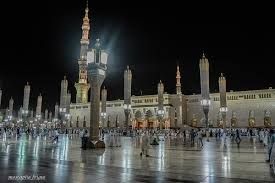
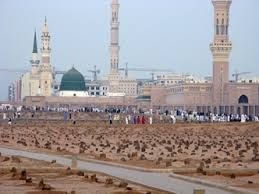
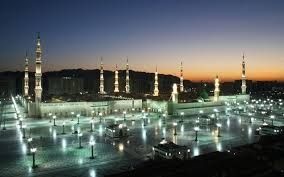
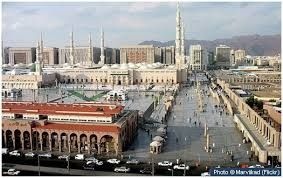
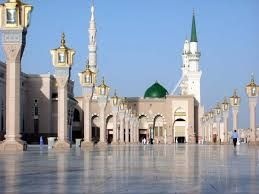
Yathrib was renamed Medina from Madinat al-Nabi ("city of the Prophet" in Arabic) in honor of Muhammad's prophethood and death there. (Alternatively, Lucien Gubbay suggests the name Medina could also have been a derivative from the Aramaic word Medinta, which the Jewish inhabitants could have used for the city.[31])
Under the first three caliphs Abu Bakr, Umar, and Uthman, Medina was the capital of a rapidly increasing Muslim Empire. During the period of Uthman, the third caliph, a party of Arabs from Egypt, disgruntled at his political decisions, attacked Medina in 656 AD/35 AH and murdered him in his own home. Ali, the fourth caliph, changed the capital of the caliphate from Medina to Kufa in Iraq. After that, Medina's importance dwindled, becoming more a place of religious importance than of political power.
After the fragmentation of the caliphate, the city became subject to various rulers, including the Mamluks of Cairo in the 13th century and finally, in 1517, theOttoman Empire.[32]
World War I to Saudi control[edit]
In the beginning of 20th century, during World War I, Medina witnessed one of the longest sieges in history. Medina was a city of the Turkish Ottoman Empire. Local rule was in the hands of the Hashemite clan as Sharifs or Emirs of Mecca. Fakhri Pasha was the Ottoman governor of Medina. Ali bin Hussein, the Sharif of Meccaand leader of the Hashemite clan, revolted against the Caliph in Constantinople (Istanbul) and sided with Great Britain. The city of Medina was besieged by the Sharif's forces, and Fakhri Pasha tenaciously held on during the Siege of Medina from 1916 till 10 January 1919. He refused to surrender and held on another 72 days after the Armistice of Moudros, until he was arrested by his own men.[33] In anticipation of the plunder and destruction to follow, Fakhri Pasha secretly sent theSacred Relics of Medina to Istanbul.[34]
As of 1920, the British described Medina as "much more self-supporting than Mecca."[35] After the First World War, the Hashemite Sayyid Hussein bin Ali was proclaimed King of an independent Hejaz. Soon after, in 1924, he was defeated by Ibn Saud, who integrated Medina and the whole of the Hejaz into the modern kingdom of Saudi Arabia.
Medina today[edit]
Modern city of Medina
Today, Medina ("Madinah" officially in Saudi documents), in addition to being the second most important Islamic pilgrimagedestination after Mecca, is an important regional capital of the western Saudi Arabian province of Al Madinah. In addition to the sacred core of the old city, which is off limits to non-Muslims, Medina is a modern, multi-ethnic city inhabited by Saudi Arabs and an increasing number of Muslim and non-Muslim expatriate workers: other Arab nationalities (Egyptians, Jordanians, Lebanese, etc.), South Asians (Bangladeshis, Indians, Pakistanis, etc.), and Filipinos.
Geography[edit]
The soil surrounding Medina consists of mostly basalt, while the hills, especially noticeable to the south of the city, are volcanic ash which dates to the first geological period of the Paleozoic Era.
Al Madinah Al Munawarah is located at Eastern Part of Al Hijaz Region in the Kingdom of Saudi Arabia on longitude (39 36 6) and Latitude (24 28 6).
Madinah is located in the north-western part of the Kingdom, to the east of the Red Sea, which lies only 250 km (155 miles) away from it. It is surrounded by a number of mountains: Al-Hujaj, or Pilgrims' Mountain to the West, Salaa to the north-west, Al-E'er or Caravan Mountain to the south and Uhad to the north Madinah is situated on a flat mountain plateau at the junction of the three valleys of Al-Aql, Al-Aqiq, and Al-Himdh. For this reason, there are large green areas amidst a dry mountainous region. The city is 620 meters (2034 ft) above sea level. Its western and southwestern parts have many volcanic rocks. Madinah lies at the meeting-point of longitude 39 36' east and latitude 24 28' north. It covers an area of about 50 square kilometers (19 square miles).
Al Madinah Al Munawwarah is a desert oasis surrounded with mountains and stony areas from all sides. It was mentioned in several references and sources. It was known as Yatrib in Writings of ancient Maeniand, this is obvious evidence that the population structure of this desert oasis is a combination of north Arabs and South Arabs, who settled there and built their civilization during the thousand years before Christ.
In 1256, Medina was threatened by lava flow from the last eruption of Harrat Rahat.[36]



